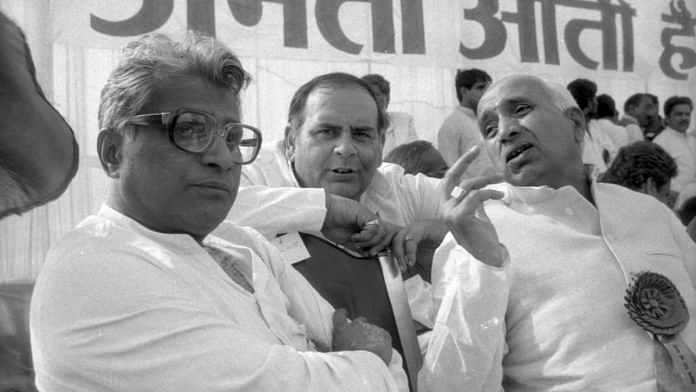Former Defence Minister George Fernandes served seven terms in the Lok Sabha as an MP from Bihar.
Patna: Roughly 2,500 kilometres separate Mangaluru in Karnataka and Muzaffarpur in Bihar. But it’s a distance — not just of kilometres but also culture — that former defence minister George Fernandes covered with ease.
Born in Mangalore, now known as Mangaluru, on 3 June 1930, Fernandes won his second stint in the Lok Sabha from Muzaffarpur in 1977, emerging on the national scene as a product of the great political churn unleashed by the Emergency.
Old-timers remember the first image of Fernandes in Bihar, which came as the country braced for the Lok Sabha election that followed the Emergency.
Fernandes, who was in jail at the time over an alleged plot to blow up government property to protest against the Emergency, never visited the constituency as the campaign began. Instead, a poster of him, handcuffed and behind bars, was displayed on a bullock cart.
Also read: Vajpayee’s defence minister George Fernandes dies at 88
Viral in the 1970s
The image, which went as viral as the pre-internet era allowed, had crowds roaring. Fernandes, contesting on a Janata Party ticket, won by a thumping majority.
After he won from Muzaffarpur, he gifted the district a thermal plant in 1978, apart from scores of other employment opportunities.
Only a few took on the Emergency like George saheb.
RIP #GeorgeFernandes pic.twitter.com/ynfxaBpySX
— Gautam Chintamani (@GChintamani) January 29, 2019
“In the 1970s, for everyone who participated in the Jaiprakash Narayan movement, George was a a hero,” Bihar Deputy Chief Minister Sushil Kumar Modi told ThePrint after Fernandes’ death.
“We all wanted to follow and copy him as a leader,” added Modi who, as general secretary of Patna University, was among the leaders of the student agitation led by Narayan that preceded the Emergency.
The 1977 election marked the transformation of trade unionist Fernandes, who had made his Lok Sabha debut by defeating three-time Congress MP S.K. Patil from Bombay (South) in 1967, as a national leader with “Bihari roots”. He altogether won four elections from Muzaffarpur, besides three others from Bihar’s Nalanda.
“It was remarkable the way he campaigned,” said Ramesh Singh, a local progressive farmer of Nalanda district. “He spent just three days in Nalanda… But he made sure that the people of his constituency were able to get their work done in Delhi, like getting medical treatment in AIIMS,” he added.
“He gifted Nalanda an ordnance factory and a Sainik School,” Singh said. “The local people used to call him ‘Jarje Saheb‘. Everybody has fond memories of Jarje Saheb. He was able to establish a connect with locals.”
Challenging the Lalu hegemony
Fernandes played a major role in Bihar politics, becoming the central challenge to Rashtriya Janata Dal (RJD) chief Lalu Prasad’s hegemony after a fallout with him in the 1990s.
The fallout, which happened during the days of the Janata Dal, was ugly. Fernandes complained that he was being ignored by Lalu, and the latter’s followers began to call him “fraud Fernandes”, with Lalu himself accusing him of interference.
Fernandes broke ranks and, along with Nitish Kumar and the late former chief minister Abdul Ghafoor, formed the Samta Party in 1994. Fernandes was appointed its national president.
After Samta Party performed disastrously in the 1995 polls, Fernandes designed an alliance with the Bharatiya Janata Party that ultimately ended Lalu’s rule in Bihar in 2005. By then, the Samta Party had merged into the Janata Dal (United).
“Due to his status as a national political leader, Goerge used to dictate terms to [senior BJP leader] L.K. Advani and the late [former Prime Minister] Atal Bihari Vajpaiyee,” said a senior leader of the Janata Dal (United), adding that the BJP conceded as many as 18 of Bihar’s seats [54 at the time] to the newly formed party in the 1998 Lok Sabha polls.
“It is a thing Nitish Kumar could not do,” the leader added.
Also read: Unlike anti-Congressism, politics of anti-BJPism is still to ripen in 2019
Differences with Nitish
It is said that it was at the instance of Fernandes that the BJP went easy on raising polarising issues such as the Uniform Civil Code, Ram Mandir and Article 370.
However, differences cropped up between Nitish and Fernandes just before the February 2005 assembly polls, which threw up a fractured verdict and were followed by another election exercise in eight months.
Nitish then replaced Fernandes as the national president of his party with Sharad Yadav. In 2009, a controversy arose with allegations that Fernandes had been denied a Janata Dal (United) nomination from Muzaffarpur.
While Nitish said the decision was inspired by Fernandes’ frail health, the latter accused him of spreading canards and contested as an Independent.
“But, in 2009, it was evident that he was not the same George Fernandes we worshipped,” said former Muzaffarpur MLA Ganesh Yadav. “He was not mentally alert and looked lost.”
Fernandes lost, with Nitish “rehabilitating” him with a Rajya Sabha seat.
“If I were to evaluate George Fernandes’ role in Bihar, it would be in black and white,” said RJD national vice-president Shivanand Tiwari.
Also read: Why Nitish Kumar, the ‘social reformer’, has left ally BJP wary
“He was a towering figure. He managed to win seven times in Bihar despite not having a caste identity. He gave the state several development projects,” he added. “But, at the same time, it was George Fernandes who allied with the BJP just a short time after the demolition of Babri Masjid.”
The alliance proved a stepping stone for the saffron party to emerge as a major political force. The BJP, previously known as an urban party, extended its influence to rural areas with the help of socialists.



